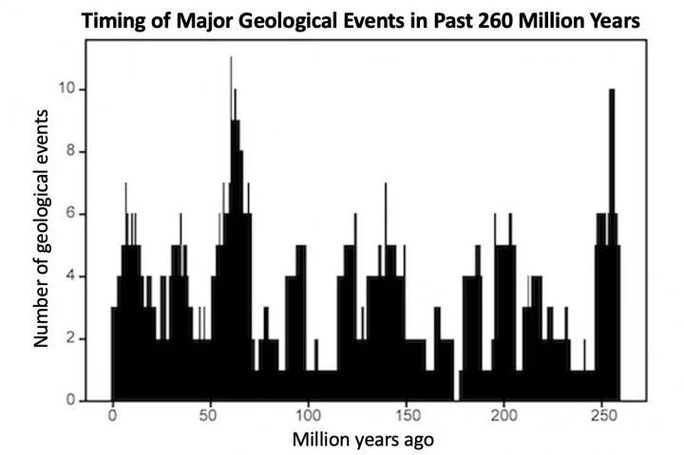Detecting Earth has a 'heartbeat': Shivering warning of disaster
A series of terrifying natural disasters and mass extinction events have revealed the Earth's heartbeat - a cycle of 27.5 million years that is completely extreme.
"Many geologists believe that geological events are random over time, but our study provides statistical evidence for a common cycle: these geological events are correlated and not random," geologist Michael Rampino from New York University (USA), lead author of the study, said in Science Alert.
Dr Rampino and his colleagues analyzed the ages and patterns of occurrence of 89 known geological events from the past 260 million years.

Disaster chart of the Earth over the past 260 million years
It is a series of volcanic activities, continental inundation basalt eruptions, anoxic ocean events, plate restructuring, sea level rise, closely related to mass extinction events - the "end days". status" of many species, in every way that the human imagination and film can express.
Mysteriously and terrifyingly, they gathered the 89 disasters into eight major "world-changing" clusters of events, forming a regular, heartbeat-like graph with "disaster pulses".
Since about a century ago, there have been scattered studies showing that the Earth seems to have a major disaster every 30 million years, or 26.2 million years, or 30.6 million years.
But with the latest calculations, the authors claim the exact number is 27.5 million years for each "catastrophic beat" of the planet's heart. It is also a time period that always ghostly coincides with mass extinction events.
The team suggested a number of possible causes for Earth's catastrophic "heartbeat": due to the comet's strike cycle, due to some "planet X" impact.
However, in their latest publication in Geoscience Frontiers, they suggest that these tectonic and climate change cyclic pulses may be the result of geophysical processes related to the dynamics of plate tectonics and cyclic changes of the coating.
It is also possible that the very mantle and core of the Earth - what drives plate tectonics - also work in cycles because of the motion of the Earth in the solar system and galaxy.
- Detecting the star system 'heartbeat' super strange in the universe
- Disaster warning by satellite positioning
- Alert Map - Real-time disaster warning
- Japan introduced automatic disaster warning system
- Extend the tsunami warning system function
- Dynamic earth 7.8 Richter off Indonesia
- Develop tsunami warning method by GPS
- Japan's new
- Use laptop to alert earthquakes
- Indonesia developed a tornado early warning system
- Recreating the meteorite disaster 66 million years ago made the dinosaurs extinct
- ASEAN prioritizes food security and disaster warning
 The most famous scientific failures in history
The most famous scientific failures in history Mysterious genius mechanic and the machine froze time
Mysterious genius mechanic and the machine froze time The son carries the 'bad gene' of genius Albert Einstein
The son carries the 'bad gene' of genius Albert Einstein Isaac Newton
Isaac Newton